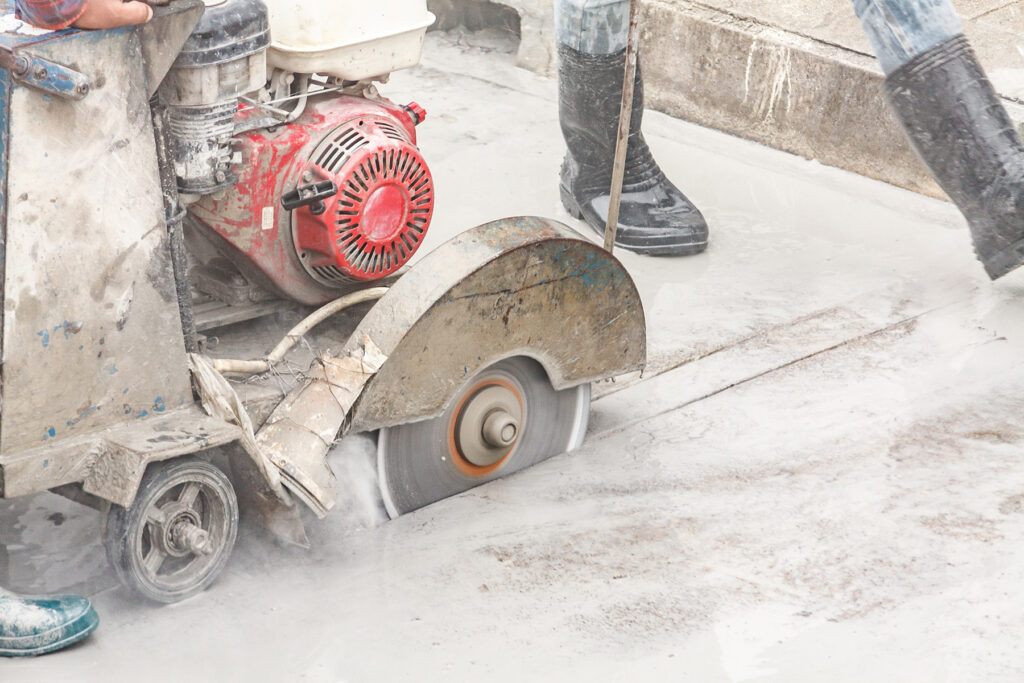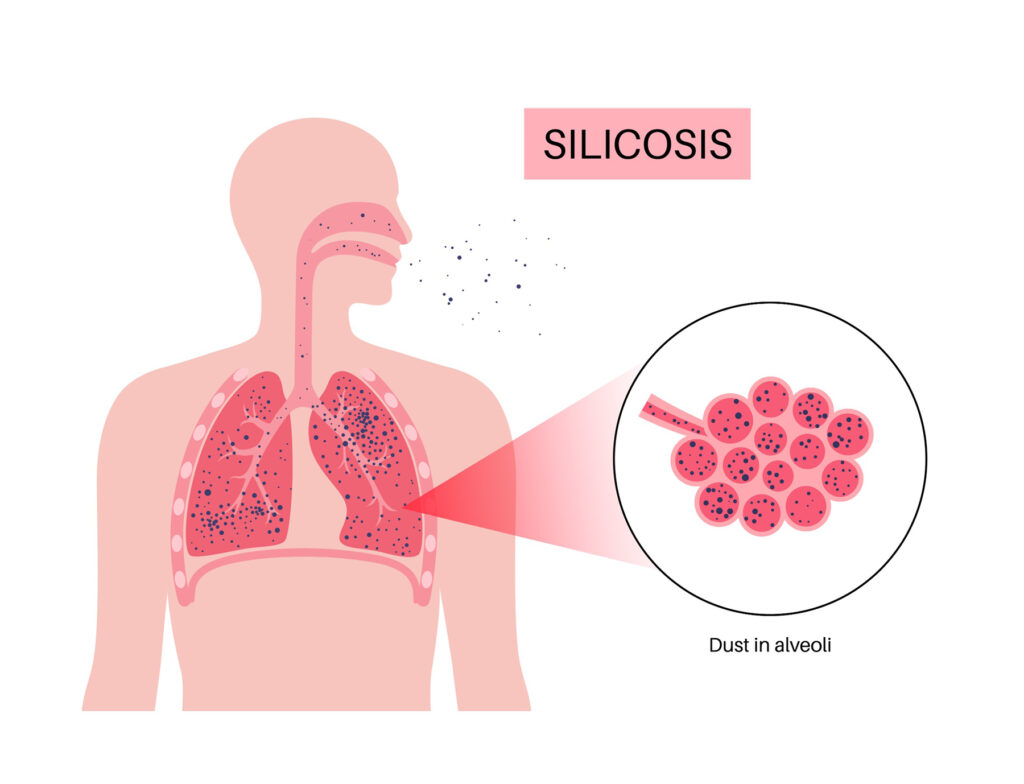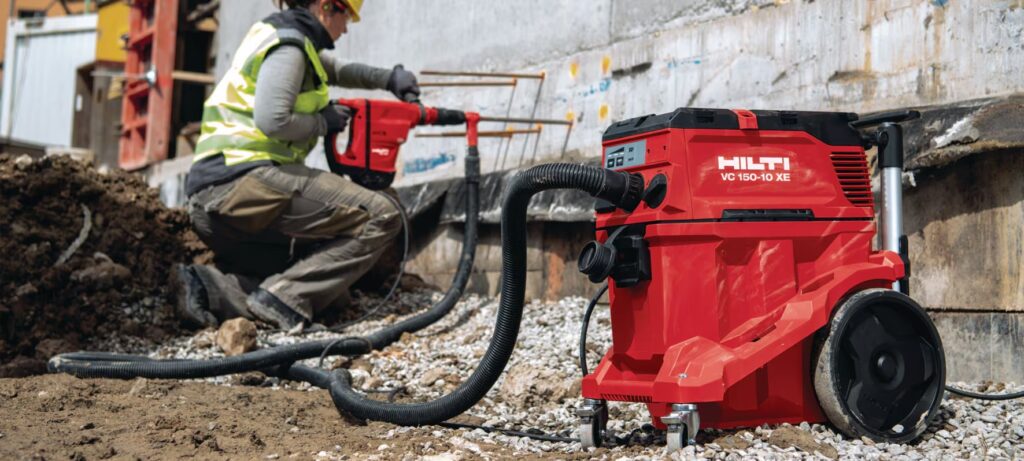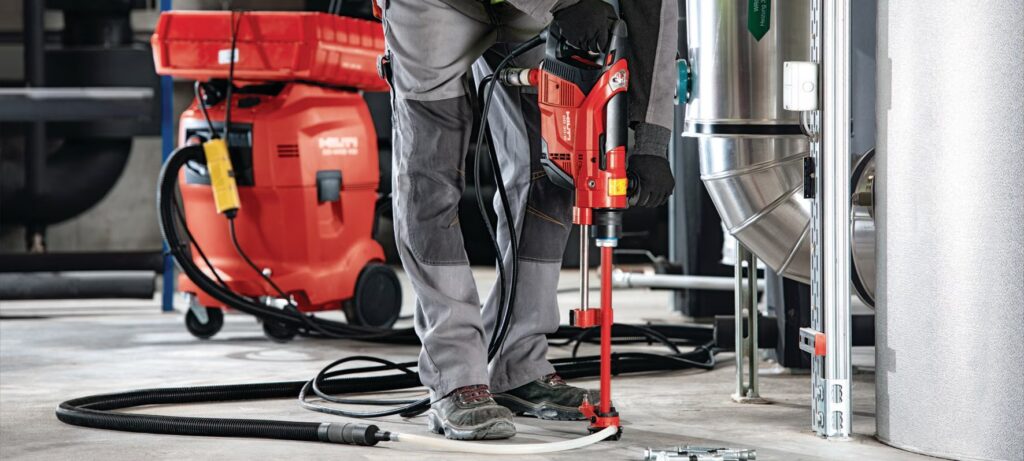Safety is our first and primary consideration when it comes to each and every project at Haydon Bridge Construction. Accident prevention is a large part of our project planning to avoid injuries by slips, trips and falls; being struck by falling tools, materials, or equipment; electrical accidents by nearby powerlines; equipment accidents; and even waterway or land collapses. Those are detrimental to a workers’ health and safety, and cause immediate harm, but there are other dangers to consider that can take months or years to manifest.
The lives of our employees, subcontractors and everyone authorized to be on or near our job site is our number one priority, thus we take time to consider all dangers to their short term health as well as long term health implications. One of those considerations is the long-term exposure to Silica Dust* on construction projects during cutting, drilling, and grinding into rock, sand, clay and cement. Prolonged exposure to silica dust can cause a progressive and irreversible lung disease, caused Silicosis*. (*See our glossary below).
This article will discuss the following questions:
- What is the history of Silicosis in the US and when was it first determined to have detrimental effects?
- How were these dangers addressed by legislation, OSHA regulations and equipment technological advancements?
- How is exposure to silica dust measured?
- And how does Haydon Bridge Company protect their workers’ respiratory health?
The Hawks Nest Tunnel Disaster in WV
It all started in the late 1920’s to early 1930’s in the small town of Gauley Bridge, West Virginia, where the Hawks Nest Tunnel, a major hydroelectric water diversion tunnel, was undertaken by Union Carbide. Starting in 1927, nearly 3000 men began working on the project, and up to 5000 workers were engaged by 1932, consisting of local men and migrant workers, with nearly 70% of them were southern Blacks. Although at once considered an engineering marvel and the biggest project licensed in WV, unfortunately, it became the site of one of the worst industrial tragedies in the history of the United States. Gauley Bridge is now known as the ‘the town of the living dead.’
In all, 2,982 men worked underground drilling and blasting through three miles of solid rock. Only 40 percent of the underground work force worked more than two months and only 20 percent more than six months. Yet, silicosis afflicted an astonishingly high proportion of this short-tenured work force.
During their months-long contracts, these workers endured prolonged exposure to silica dust—without respiratory protection—while mining sandstone. The combination of drilling and blasting in confined spaces underground, poor ventilation and lack of dust control or personal breathing protection, these men were inhaling pulverized silica dioxide, a recognized hazard in hard rock mining and in granite sheds. In less than two years of the groundbreaking of the Hawks Tunnel project, many of these young men developed silicosis and eventually died from the disease. Although the exact number of deaths caused by the disaster is unknown, some sources say more than 1,000 workers died.
What did we Learn from this Disaster? And what Subsequent Legislation and/or Work Standards have been Applied?
A 1936 report by a congressional committee found that the tunnel was completed with “grave and inhuman disregard for all consideration for the health, lives, and future of the employees”. Secretary of Labor, Francis Perkins, held a National Silicosis Conference and initiated a campaign to “Stop Silicosis.” Yet despite the attention received, many workers continued to be exposed.
“As new products, tools, and work practices have been introduced, new means of exposure were created.”
– Silica-Safe.org
In 1996, the Secretary of Labor began a new campaign to raise awareness and encourage safer work practices called “It’s Not Just Dust,” and initiated a Special Emphasis Program (SEP) on Silicosis to provide guidance to “reduce and eliminate the workplace incidence of silicosis from exposure to crystalline silica.”
In addition, OSHA, NIOSH, and the American Lung Association held a conference “The Campaign to End Silicosis.” On March 24, 2016, OSHA announced the final rule to protect workers from exposure to respirable crystalline silica. Occupational Safety and Health Administration (OSHA), Mine Safety and Health Administration (MSHA) and similar agencies have oversight and responsibility to enforce regulations that protect workers in the U.S.
Yet despite these efforts, many in the construction industry still continue to observe negligence; untrained and ill-informed workers; and responsible management ignoring required protocols.
“With the advent and increased use of dry cutting, drilling and grinding of concrete and masonry material in construction, we often see workers operating in a cloud of dust with no respiratory protection or safety measures to prevent airborne dust. Exposure levels in settings like construction sites are highly variable for airborne silica dust, which poses a significant risk to workers.”
– Masonry Magazine, December 2009
How is Exposure to Silica Dust Measured?
“Permissible exposure limit (PEL). The employer shall ensure that no employee is exposed to an airborne concentration of respirable crystalline silica in excess of 50 mg/m3, calculated as an 8-hour TWA.” [READ ARTICLE]
– OSHA.gov
What does 50 micrograms of silica per cubic meter of air equate to? Some have compared it to a 50mg dose of baby aspirin over an 8-hour period, or some have compared it to enough dust to cover a needle pin top. Again, this is not a dose of 50mg within a short period of time every eight hours, but 50mg throughout an entire 8-hour period.
How can you tell how much is being absorbed in an 8-hour day? Since only major corporations have the resources to do their own discovery, research and analysis on the risks of silica dust exposure during their construction procedures, OSHA had to get involved to protect all workers regardless of how big or small the companies that hire them are. OSHA conducted research on common construction procedures (jackhammering, chipping, drilling and grinding of stone, cement and sand), to determine the concentration of silica dust exposure for each process. To set universal standards within their jurisdiction, they provided Table 1, Table 2, and Table Z3 to determine exposure control methods when working on materials containing crystalline silica (see examples below).
Table 1 of the Occupational Safety and Health Administration’s (OSHA) Respirable Crystalline Silica standard identifies 18 construction tasks that produce high levels of silica dust. Example of Table 1 below:

Table 2 includes tasks that result in employee exposure to airborne respirable crystalline silica (RCS). These tasks are not high-exposure trigger tasks, but they do require regulated areas and housekeeping and cleanup.

Table Z3 details OSHA guidelines and permissible exposure limits for silica exposure. Exposure levels are tested by industrial hygienists (IH). If your exposure level is below the PEL, you’re good. If it’s above the PEL, then the employer must take action. In this table, you’ll also see reference to CAL/OSHA, NIOSH and ACGIH. These are merely 3rd party groups that OSHA may reference or align with when making determinations on rules. We follow OSHA guidance but if we operate in California, we’ll follow CAL guidance b/c we are under their jurisdiction there.

*See attached PDF for complete Table 1 OSHA specifications.
What are some OSHA recommended ways and equipment to prevent silica dust inhalation?
Some of these common control prevention/protective methods include:

- Isolation: This process is to enclose the work area within a safe perimeter so all dust is contained within the enclosure while all employees are placed outside, to prevent exposure. Careful attention is essential to this process to prevent employees from reentering the perimeter of exposure until the process has been completed, the dust contamination has been removed, and dust is cleaned off of all surfaces.
- Ventilation: This means using a local exhaust or vacuum tool system, the airborne dust is removed before it gets near the breathing zone of the operator and surrounding employees. It is imperative that all ventilation equipment is used according to the manufacturer’s specifications, is well maintained, consistently tested and its dust collectors regularly serviced. All on the job site also need to be trained on the proper usage of all ventilation equipment.
- Wet-Cutting or Wet Core Drilling*: Using a wet-cutting system minimizes the generation of dry dust. Wet-saws or wet-cutting systems are equipped with a water reservoir or hose attachment that supplies water to the blade and stone while cutting. The water helps cool the blade, wash away debris, and reduce friction and heat. It’s important to ensure it meets Nationally Recognized Testing Lab (NRTL) approval requirements for electrical systems in wet conditions, including GFCI-protected electrical sources. And again, ensure all are trained to operate, maintain, and service wet-cutting systems according to manufacturer’s instructions.
- Respirators & Mask: The N95 rated filter will capture 95% of the dust particles, but only a good fit ensures that all the air is filtered. As an upgrade, we suggest also looking at P100 filters. These are rated even higher, to capture 99.9% of the particulates. NIOSH (The National Institute for Occupational Safety and Health) recommends the use of half-facepiece particulate respirators with N95 or better filters for airborne exposures to crystalline silica at concentrations less than or equal to 0.5 mg/m3. Use personal protective equipment, such as a respirator and coveralls that keeps the dust off the clothes you wear home. Respirators may still be required if the above controls don’t adequately reduce exposure levels
How does Haydon Bridge Construction Protect its Team from Silica Dust Exposure?

We have created a manual to implement a list of safety protocols and standards that meet OSHA requirements. Our safety manager spends a great deal of time with project managers, foreman, workers and laborers to ensure they are well-acquainted with the risks and trained on how to protect themselves and their teammates. With the goal of keeping our employees safe, in the short term as well as their long-term health, Haydon Bridge created a Respiratory Protection Program.
“Haydon Bridge Company has determined that employees working with certain job activities may be inadvertently exposed to respiratory hazards. Specifically, employees may be exposed to hazardous levels of silica dust during concrete grinding, cutting, mixing and any other activities that produce a ‘cloud’ of dust. Additionally, employees may be exposed to hazardous levels of lead during certain phases of demolition work, particularly on old bridge structures. The purpose of this program is to identify where health hazards exist and educate employees how to protect themselves, to define work procedures and train employees how to properly complete tasks within hazardous areas.” – Bill Pettus, Safety Manager
Various silica dust protective standards are implemented during any job where cutting, grinding or drilling into stone, sand, rock is taking place:
- Testing of Exposure Level: In an attempt to better understand silica and lead exposures in the workplace, Haydon Bridge periodically conducts air sampling tests to ensure the air is is below allowed OSHA set limits. Repeated air sampling of these processes is made if construction site environmental variables change, including temperature, humidity, wind speed, location of drilling whether outdoor or enclosed, type of rock/material being drilled, and the equipment being used at various times throughout the project.
- Project Safety Management: Our safety manager is made aware of all jobs on any given project that may generate silica and lead hazards, to prepare and enforce the proper use PPE, wet-core drilling equipment and safety procedures.
- Safety Training: All employees are made aware of not only the dangers of Silica Dust exposure, but how to protect themselves with training on (1) all equipment according to manufacturers’ specifications, (1) proper use of PPE and respirators, and (3) how to conduct regular evaluations and maintenance and of all safety equipment and respirators. They are taught to communicate any concerns where respiratory hazards are not adequately being addressed, if equipment needs new consumable parts (filters, bags, water reservoir, vacuums, etc.) or when equipment is not functioning properly.
- Equipment Training according to OSHA Table 1 standards: OSHA Table 1 defines the exact engineering work practices and controls to follow when using equipment or tools that will produce respirable silica. Haydon Bridge follows these controls and methods on our jobsites when applicable. Our rule of thumb is “if you see a cloud of dust, you are doing it wrong.” All employees are trained on a consistent basis to ensure that they know the precautions to take before using any equipment.
- Medical Evaluations: Employees are not permitted to wear a respirator on Haydon Bridge jobsites until a professionally licensed health care provider (PLHCP) has determined that they are medically able to do so. Any employee refusing the medical evaluation will not be permitted to wear a respirator and, as a result, not be allowed to perform any job tasks that require respirator usage. Employees who have successfully completed a medical fit test will sign the Respiratory Protection Program acknowledgement form.
- Continual Monitoring of Job sites by our Safety Manager: Our safety manager regularly visits job sites to conduct risk assessments and observe the processes used to ensure that are safety protocols are being correctly implemented, and which need correction/revision.
- Use of Hilti Tools and Equipment: Hilti is committed to helping reduce risks associated with respirable crystalline silica as well as increase the productivity on site with dust control tools and services designed to greatly reduce silica dust exposure. [MORE INFO]
In Conclusion
Here at Haydon Bridge Company, we view our team as part of our family, and as any family member, we look out for their health and safety. We want all of our employees to live a long, healthy life beyond retirement, so these safety measures are not just OSHA requirements for us, but this is a valued mission to protect our employees lives and health. For now and for their future.
*Glossary of Terms:

Silica dust: is a fine dust that can be released when working with materials that contain silica, a natural substance found in rocks, sand, clay, and construction materials. The most common form of silica is quartz. Silica dust is generated during construction tasks like cutting, drilling, grinding, and polishing.
Silicosis is a progressive, irreversible lung disease that occurs when someone inhales crystalline silica dust. Silica is a mineral found in sand, quartz, and other types of rock. Silicosis causes inflammation and scarring in the lungs, which reduces the lungs’ ability to take in oxygen. It can lead to permanent lung damage and can be fatal. Throughout history, it has had names such as miner’s phthisis (tī’sis), grinder’s asthma and potter’s rot. There are three types:
- Acute: Symptoms appear a few weeks to 2 years after large exposures to silica.
- Chronic: Problems may not manifest until decades after exposure to low or moderate amounts of silica. It is the most common type of silicosis. Symptoms may be mild at first and slowly worsen.
- Accelerated: Signs will be noticed about 5 to 10 years after heavy exposure to silica. They will worsen quickly.
- Complications from silicosis can include tuberculosis, lung cancer, chronic bronchitis, autoimmune disorders and kidney disease. There is no cure for silicosis.

Wet Core Drilling: Wet core drilling is a method used to create holes in various materials such as concrete, stone, masonry, and asphalt. In this technique, a hollow cylindrical drill bit with diamond tips is used to cut through the material. Water is continuously fed into the drilling area to lubricate the cutting process, cool down the drill bit, and suppress dust. The water also helps in flushing out the debris from the hole as the drilling progresses, ensuring cleaner and more efficient drilling.
- Advantages of wet core drilling include it provides precise, clean, and relatively quick hole creation. It’s preferred over dry drilling in many cases because it reduces wear on the drill bit, minimizes dust, and can lead to faster drilling speed

Dry Core Drilling: Dry core drilling is another method used for creating holes in various materials, similar to wet core drilling but without the use of water for lubrication and cooling. In this technique, a hollow cylindrical drill bit with diamond tips is used to cut through the material, but no water is applied during the drilling process.
- Advantages of dry core drilling is reduced cleanup and no water-related issues.







